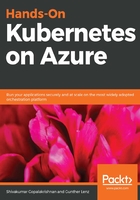
Deploying the Redis slaves
Running a single backend on the cloud is not cool. So, we run multiple slaves to handle the massive read traffic of all those who would really like to know what people think of your model railroad display. We do this by running the following command:
kubectl apply -f https://k8s.io/examples/application/guestbook/redis-slave-deployment.yaml
The output would be something like this:
ab443838-9b3e-4811-b287-74e417a9@Azure:~$ kubectl apply -f https://k8s.io/examples/application/guestbook/redis-slave-deployment.yaml
deployment.apps/redis-slave created
ab443838-9b3e-4811-b287-74e417a9@Azure:~$ kubectl get all
NAME READY STATUS RESTARTS AGE
pod/redis-master-585bd9d8fb-p9qml 1/1 Running 0 21h
pod/redis-slave-b58dc4644-2hpr7 0/1 ContainerCreating 0 3s
pod/redis-slave-b58dc4644-bz9dj 0/1 ContainerCreating 0 3s
NAME TYPE CLUSTER-IP EXTERNAL-IP PORT(S) AGE
service/Kubernetes ClusterIP 10.0.0.1 <none> 443/TCP 1d
service/redis-master ClusterIP 10.0.22.146 <none> 6379/TCP 1h
NAME DESIRED CURRENT UP-TO-DATE AVAILABLE AGE
deployment.apps/redis-master 1 1 1 1 21h
deployment.apps/redis-slave 2 2 2 0 3s
NAME DESIRED CURRENT READY AGE
replicaset.apps/redis-master-585bd9d8fb 1 1 1 21h
replicaset.apps/redis-slave-b58dc4644 2 2 0 3s
ab443838-9b3e-4811-b287-74e417a9@Azure:~$
Based on the preceding output, you can guess that this time we asked 2 replicas of the redis slave pods. That is confirmed true when you examine the redis-slave-deployment.yaml file:
1 apiVersion: apps/v1 # for versions before 1.9.0 use apps/v1beta2
2 kind: Deployment
3 metadata:
4 name: redis-slave
5 labels:
6 app: redis
7 spec:
8 selector:
9 matchLabels:
10 app: redis
11 role: slave
12 tier: backend
13 replicas: 2
14 template:
15 metadata:
16 labels:
17 app: redis
18 role: slave
19 tier: backend
20 spec:
21 containers:
22 - name: slave
23 image: gcr.io/google_samples/gb-redisslave:v1
24 resources:
25 requests:
26 cpu: 100m
27 memory: 100Mi
28 env:
29 - name: GET_HOSTS_FROM
30 value: dns
31 # Using `GET_HOSTS_FROM=dns` requires your cluster to
32 # provide a dns service. As of Kubernetes 1.3, DNS is a built-in
33 # service launched automatically. However, if the cluster you are using
34 # does not have a built-in DNS service, you can instead
35 # access an environment variable to find the master
36 # service's host. To do so, comment out the 'value: dns' line above, and
37 # uncomment the line below:
38 # value: env
39 ports:
40 - containerPort: 6379
Everything is more or less the same other than the following:
- The role is declared to be a slave.
- Replicas is equal to 2.
- We are using the gb-redisslave image.
- Setting the GET_HOSTS_FROM=dns;, we can presume that the slave is going to get the master IP using DNS. Let's check whether our assumption is correct by running the following code:
ab443838-9b3e-4811-b287-74e417a9@Azure:~$ kubectl exec -it redis-slave-<pod-id> bash
root@redis-slave-b58dc4644-2hpr7:/data# cat /proc/1/cmdline
/bin/sh-c/run.shroot@redis-slave-b58dc4644-2hpr7:/data# cat /run.sh
#!/bin/bash
#...
if [[ ${GET_HOSTS_FROM:-dns} == "env" ]]; then
redis-server --slaveof ${REDIS_MASTER_SERVICE_HOST} 6379
else
redis-server --slaveof redis-master 6379
fi
root@redis-slave-b58dc4644-2hpr7:/data# root@redis-slave-b58dc4644-2hpr7:/data# ping redis-master
PING redis-master.default.svc.cluster.local (10.0.22.146): 48 data bytes
As expected, run.sh in the image checks whether the GET_HOSTS_FROM variable is set to env. In this case, it is set to dns, so it returns false. redis-server is launched in slave mode pointing to the redis-master host as the master. If you ping redis-master, you can see it is set to the ClusterIP of the redis-master service.
Similar to the master service, we need to expose the slave service by running the following:
kubectl apply -f https://k8s.io/examples/application/guestbook/redis-slave-service.yaml
apiVersion: v1
kind: Service
metadata:
name: redis-slave
labels:
app: redis
role: slave
tier: backend
spec:
ports:
- port: 6379
selector:
app: redis
role: slave
tier: backend
The only difference between this Service and the redis-master Service is that this service proxies traffic to pods that have the role:slave label in them.
Create the redis slave service by running the following command:
ab443838-9b3e-4811-b287-74e417a9@Azure:~$ kubectl apply -f https://k8s.io/examples/application/guestbook/redis-slave-service.yaml
service/redis-slave created
ab443838-9b3e-4811-b287-74e417a9@Azure:~$ kubectl get service
NAME TYPE CLUSTER-IP EXTERNAL-IP PORT(S) AGE
Kubernetes ClusterIP 10.0.0.1 <none> 443/TCP 1d
redis-master ClusterIP 10.0.22.146 <none>; 6379/TCP 2h
redis-slave ClusterIP 10.0.14.218 <none> 6379/TCP 3s
ab443838-9b3e-4811-b287-74e417a9@Azure:~$
To check whether the slave service responds at the mentioned ClusterIP and port 6379, run the following commands:
kubectl run checkredisslave -it --image ubuntu
# on the terminal or run
kubectl attach <pod-name> # to get to the terminal
# apt update
apt install -y netcat # re-run apt update in case you copied the # by mistake in the previous command
nc -vz <redis-slave ClusterIP> 6379
# you should get ... (?) open